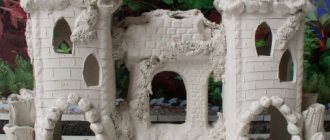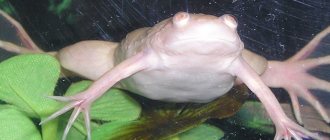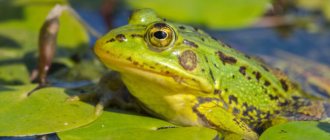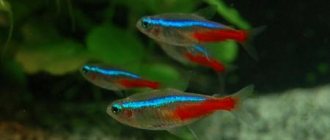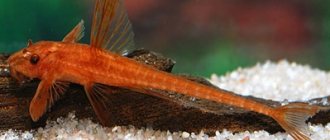Frogs are unusual pets that live quite an interesting life in an aquarium with water. They unusually hang in the water, swim like real divers, and explore their domain. Watching them is just as interesting as watching fish.
You can buy a frog at a pet store. It also contains everything you need to properly maintain an amphibian pet at home.
In the article we will tell you what types of frogs are suitable for keeping at home, how to choose the right home for your pet, how to equip it, temperature conditions and lighting, water purification, soil and shelters, plants, how and what to feed the frog and tadpoles, how to breed, advantages and the disadvantages of keeping frogs at home.
Who are frogs?
In order to understand the proper maintenance of such creatures and understand who frogs are, you need to understand what exactly they are.
So, frogs are part of one large class of Amphibians or Amphibians. What should we understand from this? And the fact that these creatures can live both on land and in water. This animal kingdom has a separate order in this class - Anurans, which has about 6,000 modern and 84 fossil species.
Red-eyed tree frog
Red-eyed tree frog (Agalychnis callidryas) Nightmare: Fireball. In an aquaterrarium, toads are distinguished by their unpretentiousness to living conditions. These are typical semi-aquatic amphibians. There are only three species: red-bellied, yellow-bellied and Far Eastern (Japanese). The size of an adult toad usually does not exceed 5 cm in length. Their back is brown, almost black or gray, and their belly is bright. The mucous tubercles of the toad secrete a foamy secretion - frinocin - a rather strong poison for small animals and birds. But it is not dangerous for humans.
These amphibians are diurnal and spend most of their active life in water. They feed mainly on invertebrates and insects. With the onset of darkness, the toads “sing” - monotonously and melancholy. The voices of many fire toads sound like a concert of low-tone spiritual instruments. Their singing is so mesmerizing that legends attribute their voices heard in swamps and lakes to spirits and various evil spirits. Therefore, it is worth thinking carefully: are you and your neighbors ready for such nightly tests?
Who Shouldn't Own a Frog
Perhaps, it’s worth thinking about getting a frog if these creatures don’t cause you panic or disgust, since all people perceive the environment and its inhabitants differently. Since antiquity, these animals have been viewed with apparent ambivalence. Some attributed them to participation in witchcraft rituals, where they were used as ingredients, while others had beliefs that it was impossible to kill them, as they brought good luck and prosperity to the house.
If you consider a frog as an ordinary animal, with its own characteristics, behavior and character, then you can see that they are quite pleasant creatures. They have beautiful expressive eyes, a whole variety of colors, and their movements are very interesting to watch. They are fun to look after.
Amphibian breeding
Before breeding begins, amphibians need to create appropriate conditions. During this period, water changes are performed 2-3 times a week. The water itself should be slightly warmer than usual. When black stripes appear on the male’s paws and he announces his readiness to spawn with a characteristic sound, the pair is placed in a spawning tank with clean water and a suitable substrate. After the eggs are laid, the parents are placed back in the aquarium.
The clutch can consist of 50-200 eggs. The tadpoles that emerge from the eggs are only about 3 mm in size. These babies should be fed rotifers and ciliates. Young frogs become adults by the end of their first year of existence. Xenopus can live in an aquarium for up to 15 years if all necessary conditions are met. Hymenochiruses are given about 5 years of life by nature.
Benefits of Keeping a Frog
The advantages of such a pet include not only their cute appearance, but also their ability to adapt to any climate conditions. This class of animals has perfectly mastered the entire globe and was able to adapt to life in any element. If you were sure that they live only in ponds and swamps, your knowledge will be expanded. Their habitats are much wider than those familiar to us. They mastered the desert and polar borders. They live both in the city and in wild places where people have not lived at all.
If you have thought about it and decided to purchase such a pet, then you will need to be careful about the type of frog that you prefer. Each species is unique in its own way.
Types of frogs to keep
Common tree frog
This small tree frog can most often be found in terrariums. She has a good appetite, a gentle character, and entertaining behavior. It is not difficult to keep, but it is worth noting that it eats live insects. If you come across a male of this species, expect periodic chants, this is their nature. Among this species there is a whole variety: , harlequin tree frog, red-eyed tree frog, coral tree frog. But it is worth noting that many of them are poisonous! Please take this into account when purchasing. Always wash your hands after handling them.
Slingshot
Due to her appearance, as well as her large mouth and huge belly, she was nicknamed Pacman (the character from the video game Pac-Man). It comes in a variety of colors and is perhaps the most popular type of frog to keep at home. She has good eyesight and is good at hiding. This can be great fun, since the slingshot also changes color depending on the interior. He leads a sedentary lifestyle, which simplifies the issue of space. The slingshot eats live food, such as crickets.
Far Eastern Fire Toad
In appearance it resembles a toad. Ideal for home keeping, as it has a beautiful color and is active during the day. The toad eats live insects. It doesn't grow too big.
African dwarf
This is a small, active frog that requires little care and is perfect for beginners. It does not require constant presence in the water. No live food required.
Other types of frogs
These are just a few of the available options to choose from. In any case, it is better to purchase familiar types of frogs that you can keep at home.
It is better to refuse wild species, due to the complexity of properly maintaining an unknown species (unless, of course, you are an expert in this field), dietary requirements and your own safety. In addition, a frog caught in the wild may be a protected species, and taking it from its natural habitat will disrupt the population of its species.
Australian tree frog
In outline it somewhat resembles the Dominican one, but does not look so intimidating. Her back is bright green, her belly is white, and her eyes are golden. During the mating season, it acquires a sky-turquoise color. But if the Australian tree frog is capable of pleasing the eye, at least for lovers of exotica, its musical abilities are very doubtful. The male's voice resembles the distant barking of irritated dogs. The female's voice is louder and more shrill.
So, during your absence, you can place the aquaterrarium near the front door to scare away thieves. Just do not feed such a tree frog immediately before the “watchdog”. After a hearty lunch, she will sit down to “meditate” for a long time, comically folding her front paws.
Selecting a space
You can determine the size of your terrarium (or other tank) by the size of your adult frog. For a more accurate selection, the points below should be taken into account.
Type of frog
You need to know exactly what type of frog you choose to have an accurate idea of how big it can grow. When you come to a pet store, do not be put off by the sellers: they may be poorly informed on this issue. It’s better to read about certain species right away, look for information about them, and only after you are absolutely sure of the characteristics of your pet, buy a tank.
Frog size
The larger the frog, the more free space it will need. If the aquarium is small, your animal will get sick and suffer; you definitely won’t make it happy. Small species require less food and aquarium stocking costs, which in turn makes them more desirable to novice owners. You will have to clean up less after them. Some species have a tiny appearance, but this can be deceiving. For example, the Elf frog - its initial size is 2.5 centimeters, and it can reach 20 cm. Always check first.
Garlic
Toads need a very spacious home. The soil in it should not be loose - otherwise your pets will sit in it all day long. The spadefoot spadefoot is considered an unsurpassed digger. It completely buries itself in the ground in 1-3 minutes, and does it backwards - backing away and desperately working with its hind legs, it disappears underground. The spadefoot rarely uses its voice, and this is undoubtedly its positive quality, because its timbre is very unique and high.
This toad makes a very loud squeal. It is curious that the tadpoles of the spadefoot toad reach a length of 10 cm, while the parents are only 5-6 cm. Another representative of the toad, the gray toad, is distinguished by its longevity: 30 years or more.
Types of frog tanks
- Ground tank
. This is the simplest type. Suitable only for land amphibians.
- Water tank
. This species is for aquatic amphibians only.
- Tank, where the ratio is 50/50
. The most common type is where half is filled with water and the other half is dry. This is the kind of home that suits most frogs.
- Wood tank
. The name says it all, this home is only for arboreal species that love branches. This house is tall and narrow, unlike the others. - Pond
. If you have a private plot, you can create your own pond there, where you can add several species of native frogs.
Narrowmouths, or microfrogs (Microhylidae).
Tomato narrowmouth - Dyscophus antongilii
The most famous, and perhaps the most striking representative of the family in every sense is the tomato narrowmouth. Size 6-10 cm. The frog is a burrower, so moist soil 5-8 cm thick is required. The maintenance temperature is standard for tropical inhabitants: 23-26°C, higher temperatures (about 30°C) can cause the death of the narrowmouth. Burrowing frogs are not suitable for my terrarium, so I will not dwell on them in detail. Although, of course, they look amazing...
Temperature
It all depends on the type of frog you have. Most of them do not require special lighting. If the house is located far from natural light, a 12-hour light source is required. Use a lamp with fluorescent lamps for this - this is the safest option. If you need to change the temperature in your aquarium, the easiest option is to cool or heat your apartment. The temperature in the water can be heated with a glass tube, which is sold in specialized stores, or with an immersion water heater. This entire process must be constantly monitored and the frog must be provided with a safe place to stay during this time.
Care
Frogs catch cold easily when the temperature drops sharply. In this situation, special aquarium heating is used to maintain a constant temperature. The reservoir is filled to half its capacity. The top must be covered, otherwise the animal will jump out of the water. There should always be access to fresh air; the top of the aquarium should not be completely closed. Examine your wards for diseases or skin lesions or wounds.
Feeding
Pets eat animal food better. Dry food is not eaten or in small quantities.
Feed Xenopus:
- worms;
- crickets;
- large bloodworm;
- fry.
Give chopped liver, shrimp, and lean meat in small quantities.
Amphibians will independently find food at the bottom or in the water of the aquarium with their keen sense of smell. Hymenochiruses feed on bloodworms, cut fish, and daphnia.
Dwarf frogs search for food for a long time, so you should place food near them.
Feeding the frog
In this matter, again, you should base your decision on the type of frog you choose.
Live food
Remember that most species of frogs prefer live food, meaning you will need to be able to buy crickets, caterpillars, worms, fish, mice. It is better to buy all these living creatures in specialized stores, and not dig them up or catch them in the garden behind the house, as these pests can be chemically poisoned.
Water
The water needs to be changed regularly. They bathe in it and drink through the skin. The water must be dechlorinated, this is important.
Copepods (Rhacophoridae).
House Copepod - Polypedates leucomystax
Famous for its ability to fly. More precisely - planning. The membranes between their fingers help them with this. Captive breeding of Polypedates leucomystax, the house copepod, has been mastered. The female reaches a length of about 10 cm, males are twice as small. This is due to the fact that during the breeding season the female carries the male on herself for a long time. It feeds on insects; the temperature and humidity are standard for tropical frogs (21-26°C, 80% and above). The cost is 2000 - 8000 rubles, there are few offers, so you will have to look.


